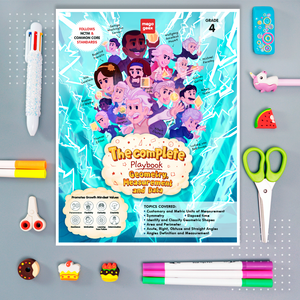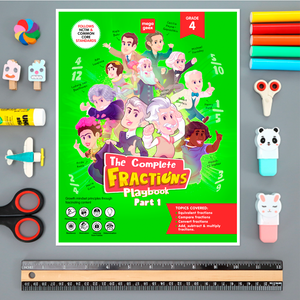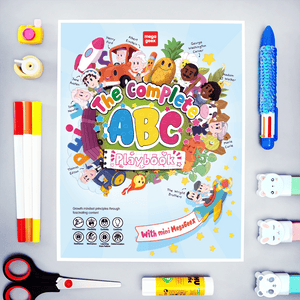Boundary Basics: How to Shape a Happier, Healthier Child
Imagine parenting without boundaries as trying to play soccer without goalposts—confusing, frustrating, and with no clear objectives. That's why understanding the role of boundaries isn't just helpful; it's fundamental to nurturing well-adjusted, independent children. Join us as we explore how setting the right limits can lead to big wins in your child's emotional and social growth.
The Importance of Boundaries in Child Development
When we think about parenting, one of the essential tools in our arsenal is the ability to set boundaries. But why are boundaries so crucial, and how do they help in child development? Let's dive into the significant roles that boundaries play in nurturing well-rounded, confident, and respectful children.
Fostering a Sense of Security
Predictability: Boundaries provide a predictable structure, which is comforting to children. Knowing what to expect from their day-to-day interactions and routines can significantly reduce anxiety and stress in children. It’s akin to knowing the rules of a game — it makes participation more straightforward and enjoyable.
Safety: Clear boundaries help children understand their limits, teaching them what is safe and what isn’t. This knowledge protects them from physical dangers (like not touching a hot stove) and social issues (learning to recognize inappropriate behavior from others).
Promoting Independence
Decision-Making: By establishing what is allowed and what isn’t, boundaries encourage children to make choices within a safe framework. For example, you might let your child choose their outfit for the day within pre-approved options you’ve set based on weather appropriateness.
Problem Solving: With boundaries, children learn to navigate minor conflicts on their own, such as deciding how to spend their free time between homework and play. This independence in decision-making fosters self-confidence and self-reliance.
Cultivating Respect
Respecting Others: Boundaries teach children that their actions have impacts on others. For instance, not grabbing toys from peers teaches them to respect others’ rights and feelings.
Personal Boundaries: Children also learn to identify and assert their own limits, which is critical for developing self-esteem and personal agency. Understanding and expressing their own needs respectfully helps them interact harmoniously in society.
Enhancing Social Skills and Self-Regulation
Social Interactions: Clear boundaries guide children in how to behave in various social settings, which is crucial for forming healthy relationships. Knowing, for example, that shouting is not acceptable in a library teaches them how to adapt their behavior to different environments.
Emotional Control: Boundaries help children learn emotional regulation by setting clear consequences for actions. This teaches them to manage their reactions and deal with frustrations in acceptable ways, laying the groundwork for emotional maturity.
Through these mechanisms, boundaries don't just manage behavior—they fundamentally shape how children understand and interact with the world around them. As we examine further, we'll look into common signs that suggest when boundaries may be insufficient and explore effective strategies for setting boundaries that evolve with your child’s growth.
Common Signs of Inadequate Boundaries
Recognizing the signs of inadequate boundaries is essential for parents, as these can have lasting impacts on a child’s behavior and emotional well-being. Identifying these signs early can help parents intervene appropriately and set the necessary limits to guide their child's development effectively.
Behavioral Indicators in Children
Excessive Demanding or Clinginess: When children lack clear boundaries, they might not understand how to manage their needs or emotions independently, leading them to constantly seek attention or reassurance from adults.
Difficulty Sharing or Taking Turns: Without firm boundaries, children often struggle to respect others’ turns or property, which can lead to frequent conflicts with peers.
Aggressive Behaviors: Children who do not understand personal boundaries may resort to physical actions, like hitting or pushing, to express themselves or get what they want.
Emotional Signs
Frequent Tantrums or Emotional Outbursts: A lack of boundaries can leave children feeling overwhelmed by their emotions, resulting in regular tantrums or meltdowns over minor frustrations.
Anxiety or Insecurity: In the absence of predictable rules and responses, children might feel insecure and exhibit anxiety, particularly in new or changing situations.
Social and Academic Challenges
Struggling to Follow Rules at School or in Social Settings: Children who do not learn boundary setting at home may have difficulty adhering to rules in other environments, affecting their social interactions and academic performance.
Difficulty Making or Keeping Friends: Without understanding boundaries, children might find it challenging to form and maintain healthy relationships, as their interactions may often be perceived as intrusive or disrespectful by their peers.
Long-Term Effects
The consequences of not establishing clear boundaries can extend far beyond childhood, potentially leading to:
Challenges in Adult Relationships: Persistent boundary issues can hinder the ability to form stable, healthy relationships later in life.
Workplace Difficulties: Adults who grew up without clear boundaries may struggle with professional interactions and respecting workplace norms.
Understanding these signs helps parents recognize when their approach might need adjusting. By addressing boundary issues early, parents can prevent more severe consequences and help their children develop into well-adjusted adults. As we move forward, we will explore practical steps to establish effective boundaries that resonate with children and foster a harmonious family environment.
Practical Steps to Establish Effective Boundaries
Setting boundaries is an essential part of parenting that teaches children how to behave within acceptable limits and understand the consequences of their actions. Here are some practical steps to help parents establish effective boundaries that are clear, consistent, and respectful.
Setting Age-Appropriate Boundaries
- For younger children, boundaries should be simple and concrete. For example, "Hands to ourselves" teaches physical boundaries clearly.
- As children grow older, boundaries can become more nuanced, reflecting their increased understanding and responsibilities. For example, older children can handle more complex boundaries like managing screen time or completing homework before playing.
Communicating Boundaries Clearly
- Use clear and positive language when setting boundaries. Instead of saying "Don't leave your room a mess," try framing it positively: "Please keep your room tidy."
- Be specific. Tell your child exactly what behavior is expected of them. Vague instructions can lead to misunderstandings.
Consistency Is Key
- Apply rules consistently. Inconsistent enforcement can confuse children and undermine the effectiveness of boundaries.
- Both parents (and other caregivers) should be on the same page regarding which boundaries are set and how they are enforced. Consistency across different caregivers provides a stable environment for the child.
Being a Role Model
- Demonstrate the behaviors you want to see in your children. If you set a boundary about yelling, make sure you also adhere to this rule.
- Show respect for others’ boundaries. This teaches children that everyone’s boundaries are important, including their own.
Creating Consequences That Teach
- Consequences should be logical and related to the boundary. For instance, if a child breaks a toy during a tantrum, a suitable consequence might be that they have to save their allowance to pay for a replacement.
- Avoid punitive measures that do not relate to the behavior. Instead, focus on consequences that encourage reflection and learning.
Encouraging Independence within Boundaries
- Allow children to make choices within the boundaries you’ve set. This fosters independence while ensuring they operate within safe limits.
- Support them in using their judgment to handle situations that relate to the boundaries. For example, deciding how to spend their allotted screen time can teach time management.
By following these steps, parents can create a framework that helps children understand what is expected of them and why those expectations exist. This approach not only helps in maintaining order at home but also greatly aids in the child's social and emotional development. As we continue, we'll discuss how to handle situations when children test these boundaries and how to manage resistance effectively.
Navigating Resistance: What to Do When Kids Push Back
Resistance is a natural part of children's development as they test limits and assert their independence. Understanding why children resist boundaries and knowing how to handle this resistance effectively can help maintain a positive and nurturing family environment. Here are strategies to navigate these challenges effectively.
Understanding the Reasons Behind Resistance
Developmental Exploration: Often, resistance is simply part of how children explore their world. Testing boundaries helps them learn about consequences and their own abilities.
Seeking Autonomy: As children grow, their desire for independence increases. Pushing against boundaries is a way for them to express and develop their sense of self.
Techniques for Managing Pushback
Stay Calm and Composed: Children look to adults for cues on how to react in stressful situations. Maintaining composure and responding calmly to resistance helps model effective emotional regulation.
Listen Actively: Sometimes, children resist because they feel unheard. Listen to their concerns and validate their feelings, which can often reduce conflict and open the door for cooperative problem-solving.
Maintaining Consistency Without Escalation
Reinforce Boundaries with Empathy: Reiterate boundaries by acknowledging the child’s feelings: “I know you want to keep playing, but it’s time for homework now. We can play again after your work is done.”
Offer Choices Within Limits: Providing options within established boundaries can help mitigate resistance. For instance, “Would you like to do your math or reading homework first?”
Educative Consequences
Natural and Logical Consequences: Use consequences that are directly linked to the behavior. If a child refuses to put away their bicycle, a natural consequence might be that the bicycle isn’t available for use the next day.
Consistent Follow-Through: Ensure that the consequences are applied consistently, and explain the reasoning behind them. This teaches children that their choices have predictable outcomes.
Frequent Review and Adjustment of Boundaries
Regularly Discuss Rules: As children grow and circumstances change, what worked once might no longer be appropriate. Regularly reviewing rules and boundaries with your child can help them understand and adapt to changes.
Adapt to Your Child's Developmental Needs: Be willing to adjust boundaries as your child matures. This flexibility can help prevent conflicts and resistance as your child’s needs and capabilities evolve.
Navigating the waters of resistance requires a blend of firmness, empathy, and flexibility. By understanding why children push boundaries and responding appropriately, parents can foster an environment of mutual respect and understanding. This approach not only reinforces the boundaries but also supports the child's emotional and social development. As we proceed, we'll look at how to adjust these boundaries as children grow, ensuring they remain relevant and supportive.
Adjusting Boundaries as Children Grow
As children mature, their needs, capabilities, and understanding of the world change significantly. It's crucial for parents to recognize when to adjust boundaries to accommodate this growth. Adapting boundaries isn’t about easing control arbitrarily; it’s about evolving with your child’s developmental stages to support their journey towards independence and responsibility.
Recognizing Developmental Changes
Increased Responsibility: As children prove they can handle more responsibility, parents can expand boundaries accordingly. For example, a later bedtime might be appropriate for a teenager who has shown they can manage their schedule responsibly.
Enhanced Understanding: Older children and teens have a greater capacity for understanding complex concepts, including the reasons behind certain rules. This understanding allows for more detailed discussions about boundaries and the values they reflect.
Evolving Communication
Open Dialogue: Maintain an ongoing conversation about boundaries. Encourage your child to express their feelings and perspectives regarding rules and limits. This dialogue can reveal insights into how boundaries might be adjusted.
Collaborative Decision-Making: Involve your child in the boundary-setting process. This inclusion can increase their commitment to the rules and their understanding of the consequences of breaking them.
Adjusting for Independence
Gradual Release: Incrementally giving children more freedom can help them learn to manage their independence. Start with small freedoms, like choosing how to spend their allowance, and gradually increase the stakes as they demonstrate readiness.
Safety Nets: While giving more freedom, it’s important to maintain certain non-negotiable boundaries for safety and well-being, such as those related to health, safety, and ethical behavior.
Preparing for the Future
Real-World Practice: Adjust boundaries to allow children to practice real-world skills. For instance, a high school student might be allowed to manage their part-time earnings to learn budgeting and financial decision-making.
Flexibility in Rules: Adapt rules based on context and circumstances rather than sticking rigidly to a set framework. For example, a curfew might be extended for special occasions, illustrating trust and the importance of context in decision-making.
Supporting Autonomy with Guidance
Guidance Over Control: Shift from a role of controlling to guiding as your child grows. This change supports their development into an independent adult who can make sound decisions.
Encouraging Self-Regulation: Teach and encourage methods of self-regulation that allow teenagers to set their own internal boundaries, preparing them for adult life where external boundaries are less apparent.
Adjusting boundaries as children grow is a dynamic and sensitive process that requires continuous attention and adaptation. By aligning boundaries with a child’s developmental needs, parents can foster a supportive environment that promotes maturity, respect, and independence. This thoughtful approach not only strengthens the parent-child relationship but also equips children with the skills necessary for successful adulthood. As we wrap up, we'll consider real-life examples of effective boundary adjustments and the positive impacts these can have on family dynamics.
Case Studies and Parental Insights
In this section, we delve into real-life examples and insights from parents who have navigated the complexities of setting and adjusting boundaries with younger children aged 5 to 12. These stories illustrate effective boundary management and demonstrate the positive outcomes that can emerge from such practices.
Case Study 1: Managing Bedtime Routines
- Background: Lucy, age 7, resisted bedtime, leading to evening tantrums and morning fatigue.
- Action Taken: Her parents established a consistent bedtime routine that included choosing a bedtime story together. They discussed with Lucy why sleep was important and how it would help her have more energy for school and play.
- Outcome: Lucy became more cooperative and even began to look forward to her bedtime story each night. Her mornings became easier, and her mood during the day improved significantly.
Parental Insight: Lucy's mother remarked, "Creating a predictable bedtime routine that included her choices made all the difference. It taught her the importance of sleep while making bedtime something she could enjoy."
Case Study 2: Enhancing Responsibility with Pets
- Background: Max, age 10, wanted a pet, but his parents were concerned about adding more responsibilities.
- Action Taken: Before agreeing to get a pet, Max's parents set a boundary that he must first demonstrate responsibility by taking care of his plants and helping with household chores. They outlined clear and manageable tasks with him.
- Outcome: Max embraced the tasks with enthusiasm and maintained his commitment over several months. His parents rewarded his responsible behavior by adopting a pet, and Max took on the pet care duties with diligence.
Parental Insight: Max's father shared, "Setting preliminary tasks helped Max prove to us—and to himself—that he was ready for the responsibility of a pet. It was a great lesson in earning and handling new responsibilities."
Case Study 3: Addressing School Performance
- Background: Sarah, age 8, was struggling with homework and often forgot assignments.
- Action Taken: Her parents and teacher set up a simple organization system with color-coded folders for each subject and a checklist for daily tasks. They also implemented a reward system for when Sarah remembered all her assignments for the week.
- Outcome: Sarah's organization skills improved, making her feel more in control and less stressed about school. Her academic performance also improved, as did her self-esteem.
Parental Insight: Sarah’s mother explained, "Helping Sarah organize her schoolwork and rewarding her efforts helped her see the benefits of staying on top of her tasks. It was a small change that made a big difference in her confidence and academic life."
These case studies show that with thoughtful, age-appropriate boundaries, younger children can learn valuable life skills, feel more secure, and achieve personal growth. By involving children in the process and clearly explaining the reasons behind boundaries, parents can foster a sense of responsibility, better behavior, and improved emotional well-being.

















